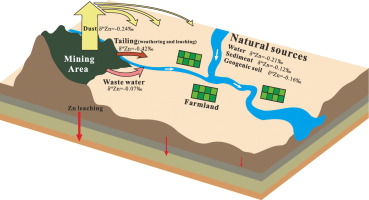当前位置:
X-MOL 学术
›
Sci. Total Environ.
›
论文详情
Our official English website, www.x-mol.net, welcomes your feedback! (Note: you will need to create a separate account there.)
Zinc isotope revealing zinc's sources and transport processes in karst region.
Science of the Total Environment ( IF 9.8 ) Pub Date : 2020-03-25 , DOI: 10.1016/j.scitotenv.2020.138191 Yafei Xia 1 , Ting Gao 1 , Yuhui Liu 1 , Zhengrong Wang 2 , Chengshuai Liu 3 , Qiqi Wu 4 , Meng Qi 1 , Yiwen Lv 4 , Fangbai Li 4
Science of the Total Environment ( IF 9.8 ) Pub Date : 2020-03-25 , DOI: 10.1016/j.scitotenv.2020.138191 Yafei Xia 1 , Ting Gao 1 , Yuhui Liu 1 , Zhengrong Wang 2 , Chengshuai Liu 3 , Qiqi Wu 4 , Meng Qi 1 , Yiwen Lv 4 , Fangbai Li 4
Affiliation

|
The heavy metal pollution, mainly caused by mining-related activities over extended period of time, is imposing a severe threat to environments and human health. Environmental systems, including rivers and paddy soils, have been widely established as one of the key sinks of potentially harmful metals. Aiming to understand contamination sources and pathways of Zn in karst area, we studied the Zn concentration and isotope composition of river waters, sediments, mine tailings, paddy soils, dust and three soil profiles with different levels of Zn-pollution around a Zn-mine, southwestern China. The distinct Zn isotope compositions among tailing (-0.42 ± 0.02‰), dust (-0.24 ± 0.02‰), and geogenic soil (-0.16 ± 0.03‰) allowed for separation of anthropogenic-Zn from native Zn. In the plot of δ66Zn value and 1/Zn, all samples can be explained by the mixing of three components: mining-input, agricultural input, and background. Evolution of these three components helps produce direct sources: dust and geogenic soil. Under this framework, the Zn pollution in paddy soil and sediment can be explained by mixing of mine-tailing, dust, and geogenic soil. Our study shows that the contamination of mine drainage is limited in the area due to the relatively high pH buffered by carbonate in karst area. While the dust contributes most of the anthropogenic Zn with an average value of 19.5%. The dominant pathway of anthropogenic Zn from dust to paddy soil or sediment is through the long-term wind dispersion of fine-grained material from the tailing and the physical transmission. Under the special hydrogeological conditions of karst, mining activities will increase the migration of heavy metals. The Fe-Al oxides control the migration of Zn in soil profile, but probably do not lead to significantly Zn isotopes fractionation. This further enhances the reliability of Zn isotopes as a "fingerprint" in karst area.
更新日期:2020-03-26



























 京公网安备 11010802027423号
京公网安备 11010802027423号